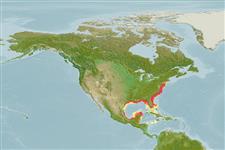Environment: milieu / climate zone / depth range / distribution range
экология
морской; пресноводный; солоноватоводный; амфидромный (Ref. 51243); пределы глубины 1 - 70 m (Ref. 93252), usually 1 - 36 m (Ref. 189). Subtropical; 42°N - 16°N, 99°W - 72°W (Ref. 189)
Western Atlantic: Casco Bay, Maine south to Florida Keys and westward around the Gulf of Mexico south to Yucatán; not in the West Indies.
Length at first maturity / Size / Вес / Возраст
Maturity: Lm 4.3, range 4 - 4.5 cm
Max length : 10.0 cm SL самец/пол неопределен; (Ref. 189); common length : 6.0 cm TL самец/пол неопределен; (Ref. 12193)
колючие лучи спинного плавника (общее число): 0; членистые (мягкие) лучи спинного плавника (общее число): 0; колючие лучи анального плавника 0; членистые (мягкие) лучи анального плавника: 23 - 31. Body variable, more slender in northern populations. Snout fairly blunt, a little over 1/2 eye diameter; maxilla long, tip pointed, reaching beyond hind border of pre-operculum, almost to gill opening; panamensis-type gill cover canals. Anal fin rays rarely 28, its origin below unbranched dorsal fin rays. Anus nearer to pelvic fin tips than to anal fin origin.
More commonly found in shallow tidal areas with muddy bottoms and brackish waters, tolerating a wide range of salinities (virtually fresh to fully saline or hypersaline). Found only in spring and summer in the tidal portion of the Ochlockonee River, Florida. Feed mostly on Mysis and copepods, also small fishes, gastropods and isopods. Breed off North Carolina from late April to mid-July, perhaps through to August. Used to some extent to make anchovy paste (Ref. 189).
Spawn in school (Ref. 205).
Whitehead, P.J.P., G.J. Nelson and T. Wongratana, 1988. FAO Species Catalogue. Vol. 7. Clupeoid fishes of the world (Suborder Clupeoidei). An annotated and illustrated catalogue of the herrings, sardines, pilchards, sprats, shads, anchovies and wolf-herrings. FAO Fish. Synop. 125(7/2):305-579. Rome: FAO. (Ref. 189)
Статус Красного Списка МСОП (Ref. 130435)
Угроза для людей
Harmless
Использование человеком
рыболовство: не имеет хозяйственного значения; наживка: usually
дополнительная информация
ссылкиаквакультура (рыбоводство)особенности рыбоводствастепень растяжениягенетикаElectrophoresesнаследуемостьболезниобработкаNutrientsMass conversion
соавторыизображенияStamps, Coins Misc.звукиCiguateraскоростьтип плаванияжаберная областьOtolithsмозгзрение
инструменты
Специальные отчеты
Скачать в формате XML
ресурсы в Интернет
Estimates based on models
Preferred temperature (Ref.
123201): 13.2 - 26.9, mean 24 °C (based on 432 cells).
Phylogenetic diversity index (Ref.
82804): PD
50 = 0.5000 [Uniqueness, from 0.5 = low to 2.0 = high].
Bayesian length-weight: a=0.00537 (0.00419 - 0.00689), b=3.15 (3.11 - 3.19), in cm total length, based on LWR estimates for this species (Ref.
93245).
Trophic level (Ref.
69278): 3.3 ±0.33 se; based on food items.
устойчивость к внешним воздействиям (Ref.
120179): высокий, минимальное время удвоения популяции до 15 месяцев (K>0.30; tmax=3).
Fishing Vulnerability (Ref.
59153): Low vulnerability (23 of 100).
Climate Vulnerability (Ref.
125649): Moderate to high vulnerability (50 of 100).
Nutrients (Ref.
124155): Calcium = 204 [126, 469] mg/100g; Iron = 1.83 [1.02, 3.40] mg/100g; Protein = 17.8 [15.4, 20.5] %; Omega3 = 0.543 [0.295, 1.019] g/100g; Selenium = 15.6 [7.4, 36.6] μg/100g; VitaminA = 28.9 [9.4, 78.9] μg/100g; Zinc = 1.42 [0.97, 2.19] mg/100g (wet weight);
